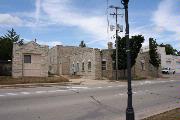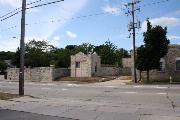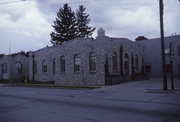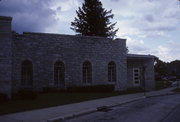| Additional Information: | A 'site file' exists for this property. It contains additional information such as correspondence, newspaper clippings, or historical information. It is a public record and may be viewed in person at the Wisconsin Historical Society, State Historic Preservation Office.
Subject location was the site of the city's first water works pumping station built in 1887. This building replaced with current pumping station and reservoir in 1936. Reservoir formerly featured an aerator fountain and glass dome lit with colored lights that became a focal point within Waukesha - fountain and glass dome removed in 1986. Complex also features a 1940 office/administration building; circa 1965 garage/equipment building and 1972 additions to both of these structures. Also a small circa 1990 booster pump station by the reservoir. In the mid-1990s the subject well was contaminated and its use discontinued. As a result, the facility no longer produces or stores water, however, it continues to serve as the department's administrative and service headquarters. A DOE was completed for this property in September 2009.
Additional Information 2024:
Architecture:
The Waukesha Water Works and pumping station is a complex of pumping station with an office wing and a large garage addition. There is also a reservoir and small booster pumping station on the lot. The complex is surrounded on three sides by a limestone veneer wall. The oldest sections of the main building feature the 1936 pumping station and a 1940 office addition, giving the main building an irregular form. Each of these sections have similar architectural features including a flat roof with stepped and embattled parapet, limestone veneer (often called “Lannon Stone”), and numerous openings in the Neo Classical Revival style. Most openings are round-arched and have 20-light windows with either extant or enclosed fanlights. They are decorated with round limestone veneer arches. Entrances into this main building are varied and consist of metal service-type doors and metal and glazed doors. The main entrance is covered with a multi-light door with a round limestone veneer arch set back under a large round arch sitting on plain posts on limestone veneer piers.
Attached to the building is the large garage addition, built around 1965. It is constructed of concrete block and has along one elevation numerous large openings covered with garage-style doors. A large addition was added to the garage in 1972. It is two-stories in height with a flat roof, concrete block walls, and openings filled with multi-light windows. Separate from the main building and garage is a smaller booster pumping station built in the same style as the main building. Erected around 1990, this pumping station has a stepped parapet roof, limestone veneer walls and round arched openings. A large opening in the main elevation is enclosed with wood panels. This large opening features a flat limestone veneer arch with keystone. The reservoir is also a separate structure. It is round with short limestone veneer walls. It is currently has a flat concrete roof. Until the mid-1990s, the reservoir had a glass and metal dome with a water spray inside and colored lights that was a landmark in the city.
History:
In 1887, a brick pumping station was built on this site as the first waterworks for Waukesha. In 1936, the top of this two-story building was removed and the first floor was extensively remodeled and expanded to create one of the older sections of this complex. The 1936-eraq complex, which consisted of a pumping station, well, heating plant, and reservoir with a greenhouse style dome, has the appearance of its 1936 remodeling and expansion. A 1940 office addition continued the same stylistic details of the 1936 building. After World War II, the building and complex received numerous remodeling efforts and several additions in 1959, 1961, 1965, 1975, 1981 and 1986. Two of these additions were large, including a concrete block utility addition and a large concrete block garage addition.
The growth of Waukesha in the later 20th century caused problems with the city water supply. As early as 1947 it looked like the water supply could only last for another 60 years. As Waukesha continued to grow in both residential, commercial, and industrial areas, contamination, in particular, radium levels in the city’s water supply were a concern. By 2000, it was clear that Waukesha needed a new source of water and the only sustainable source was Lake Michigan. After a Great Lakes agreement on the use of Great Lakes water was reached in 2008 and other agreements were made, in 2017 an agreement to pipe Lake Michigan water from Milwaukee to Waukesha was concluded. In the fall of 2023, the infrastructure was completed and soon after, Waukesha was using Lake Michigan water. In the meantime, the North Street pumping station was discontinued in the 1990s due to contamination and only offices and utility services are still using the building today. However, new facilities built for the Lake Michigan water system may result in offices being moved out of this building, threatening the preservation of the old North Street pumping station.
Carol Cartwright, 2024
|
|---|





